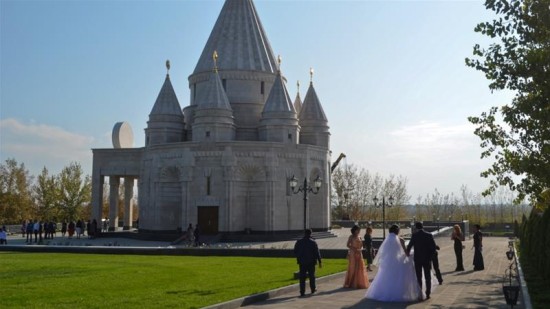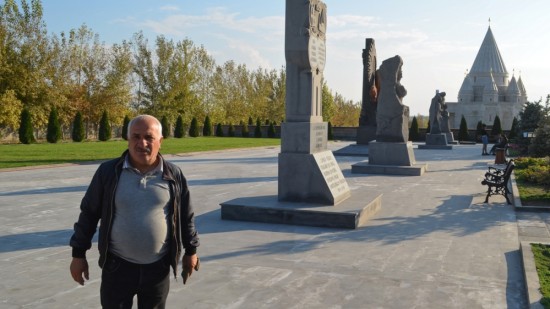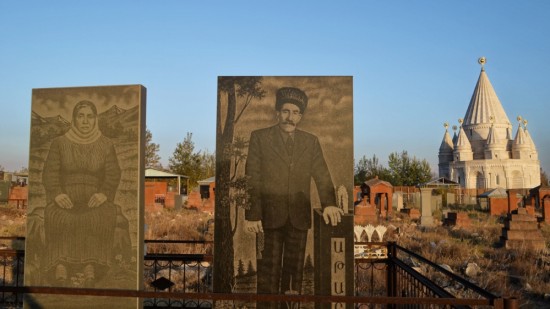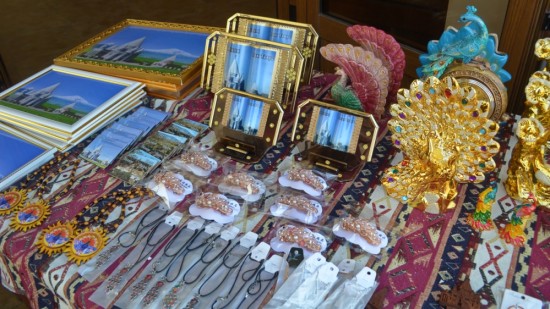
| TEMPLE IN ARMENIA On 30 September, President of Armenia Armen Sarkissian congratulated the Yazidi community over the consecration and inauguration of the world’s largest Yazidi temple Quba Mere Diwane in the Armenian village of Aknalich.
The little-known community of Yazidis made it to international news after their brutal and bloody persecution by the Islamic State in West Asia. As the Islamist terror group gained ground, the Yazidis were forced to flee and hide in the rugged mountains, where they suffered from lack of food and water. Their condition can only be described as that of those having been subjected to a “genocide”.
Yazidi Temple in Armenia :
Quba Mere Diwane Finally the Yazidis have somewhere in Armenia where they can come and pray," said 27-year-old Pakizar Salmoyan, who wandered with her mother through the gold-toned atrium on a recent Saturday.
The pair had driven down from Gyumri, a few hours by car, to see the new temple in person, and now posed for Snapchat photos in front of the altar.
Just an hour outside the capital city of Yerevan, the gleaming, seven-domed temple crowns the quiet, poplar-lined village of Aknalich.
The temple is dedicated to Melek Taus, one of seven angels in Yazidi theology, who takes the form of a peacock.
Peacock motifs are etched onto the wooden doors.
Golden suns - symbols of a higher power - adorn each white dome.
An elaborate, colourful stone carving of Melek Taus, special-ordered from Russia, is backlit to appear mystically luminescent.
A humbler, single-domed temple, which opened in 2012, sits alongside the new addition.
It displays a turquoise-feathered taxidermy peacock on a wooden pedestal and adjoins the local Yazidi cemetery.
Property manager Mraz Sloyan is pictured in the Armenian-Yazidi friendship memorial complex [Ariel Sophia Bardi/Al Jazeera] Both temples were commissioned and financed by Yazidi-Armenian property developer Mirza Sloyan, who passed away this month.
They are two of very few Yazidi places of worship outside the mountains of the northern Kurdish region, home of the community's most sacred shrine, Lalish.
"In Iraq, we have a lot of holy places," said 57-year-old Mraz Sloyan, Mirza's nephew and the temple's property manager.
Armenia, officially home to 35,000 Yazidis - with an unofficial count of 50,000 - had none.
During Soviet times, Yazidis were counted on census forms as Kurds, eroding their distinct culture and religion.
They petitioned to be recognised as a separate group. After the fall of the USSR, a Yazidi radio station was established, and schools now offer classes in Yazidi language and culture.
In 2014, when the Islamic State of Iraq and the Levant (ISIL or ISIS) forces swept through the Yazidi homeland in Sinjar, killing men and subjecting women and girls to brutal sexual assaults, the older Sloyan wanted to begin construction on the new temple, giving Armenia's Yazidi minority community more visibility and support.
"It played a role," said Sloyan, the nephew. "Before that, we were told that we were Kurds, we were Zoroastrians. But no, we are Yazidis, and we can be beheaded for our religion," he said. "We should have a place for worship."
In 2018, Armenia made news by declaring the attack on the Yazidis of Sinjar as a genocide.
"Armenians are a community who have seen genocide themselves," said Rustam Bakoyan, a Yazidi member of Armenia's parliament.
"I don't think any other nation would understand our pain as much as the Armenians did."
While Armenians describe the 1915 mass killings allegedly by Ottoman forces as genocide, Turkey has rejected this label and said the number of people who died is close to 300,000, rather than 1.5 million as claimed by Armenia.
The adjacent Yazidi cemetery [Ariel Sophia Bardi/Al Jazeera] The new reformist government - led by Prime Minister Nikol Pashinyan - has emphasised the importance of Yazidis and other minority groups to Armenia, which is still 98 percent ethnically Armenian.
During the construction of the temple, the government waived taxes on imported materials, such as marble from Iran and relics from Iraq. "The place in the world where Yazidis feel themselves the safest is Armenia," said Bakoyan.
In a new statue park facing the temple, a middle-aged man walked briskly down the line of monuments, stopping to kiss and touch his forehead to each.
One depicts Nobel Prize winner Nadia Murad, towering in broken chains.
A horseback statue honours Andranik Ozanyan, an Armenian military commander who fought the Ottomans.
Another one features an apostolic cross intertwined with the Yazidi sun, an ode to religious harmony.
"I'm impressed that the Yazidis have our heroes in their holy place," said 26-year-old Anna Alaverdyan, an ethnic Armenian visiting with her brother after they had seen news of the opening on TV.
They explored the grounds as multiple wedding parties arrived for blessings and portrait sessions, a swift succession of caged doves, buzzing drone cameras, and hired dhol drummers.
A souvenir stand in the temple [Ariel Sophia Bardi/Al Jazeera] A small gift shop sells images of the temple flanked by white-capped Mount Ararat, a sacred symbol for Armenians.
Yazidis have had a presence in Armenia for centuries, seeking refuge from the Ottomans.
Outside the temple complex, Yazidis live along a long village road aptly named Barekamutyan Street - the Street of Friendship.
A blue truck loaded with sheep rumbled down an intersection. Yazidis in Armenia work primarily in agriculture.
A group of farmers stood smoking, idling as their livestock grazed. Their grandfathers and great-grandfathers had come to Armenia after 1915, they said.
"We are very free here, like one nation. We are the same country, the same people," said 54-year-old Suren Avdoyan. The temple "brought unity to the community," he added.
"Since we don't have the opportunity to go to Iraq, now we have one just nearby and we go there," agreed 28-year-old Rustam Hasanyan.
Inside his cheerful, yellow-walled house, over a spread of pomegranates and tarragon soda, Avdoyan elaborated: "For us, Armenia is one of the best places for Yazidis to be. We have our temple, our radio station, our schools."
"We were born here, we've been fed here, and it's our motherland." Above him hung a glittering portrait of the Virgin Mary. "She's the mother of God," said Avdoyan. "We respect all the religions."
Every day at sunrise, he said, "we ask God to give happiness and wellbeing to all the people of the world - and lastly, for us".
Source :
https://www.aljazeera.com |



